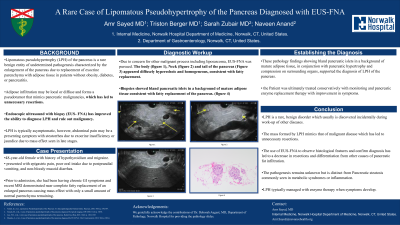Back


Poster Session D - Tuesday Morning
Category: Biliary/Pancreas
D0073 - A Rare Case of Lipomatous Pseudohypertrophy of the Pancreas Diagnosed With EUS-FNA
Tuesday, October 25, 2022
10:00 AM – 12:00 PM ET
Location: Crown Ballroom

Has Audio

Amr Sayed, MD
Norwalk Hospital
Norwalk, CT
Presenting Author(s)
Amr Sayed, MD, Triston Berger, MD, Sarah Zubair, MD, Naveen Anand, MD
Norwalk Hospital, Norwalk, CT
Introduction: Lipomatous pseudohypertrophy (LPH) of the pancreas is a rare benign entity of undetermined pathogenesis characterized by the enlargement of the pancreas due to replacement of exocrine parenchyma with adipose tissue in patients without obesity, diabetes, or pancreatitis. Adipose infiltration may be local or diffuse and forms a pseudotumor that mimics pancreatic malignancies, which has led to unnecessary resections. Endoscopic ultrasound with biopsy (EUS- FNA) has improved the ability to diagnose LPH and rule out malignancy. LPH is typically asymptomatic, however, abdominal pain may be a presenting symptom with steatorrhea due to exocrine insufficiency or jaundice due to mass effect seen in late stages.
Case Description/Methods: 48-year-old female with history of hypothyroidism and migraines presented with epigastric pain, poor oral intake due to postprandial vomiting, and non-bloody mucoid diarrhea. Prior to admission, she had been having chronic GI symptoms and recent MRI demonstrated near complete fatty replacement of an enlarged pancreas causing mass effect with only a small amount of normal parenchyma remaining. She had been diagnosed with exocrine pancreatic deficiency and started on replacement therapy. Surgery was consulted for potential resection of the body and tail of the pancreas due to compressive symptoms. Due to concern for other malignant process including liposarcoma, EUS-FNA was pursued. The body and tail of the pancreas appeared diffusely hyperechoic and homogeneous, consistent with fatty replacement. Biopsies showed bland pancreatic islets in a background of mature adipose tissue consistent with fatty replacement of the pancreas. These pathology findings in conjunction with pancreatic hypertrophy and compression on surrounding organs without a history of obesity, diabetes, or pancreatitis, supported the diagnosis of LPH of the pancreas. She was ultimately treated conservatively with monitoring and pancreatic enzyme replacement therapy with improvement in symptoms.
Discussion: LPH is a rare, benign disorder typically managed with enzyme therapy when symptoms develop. The mass formed by LPH mimics that of malignant disease which has led to unnecessary resections. The use of EUS-FNA to observe histological features and confirm diagnosis has led to a decrease in resections and differentiation from other causes of pancreatic fat infiltration. The pathogenesis remains unknown but is distinct from pancreatic steatosis commonly seen in metabolic syndromes or inflammation.

Disclosures:
Amr Sayed, MD, Triston Berger, MD, Sarah Zubair, MD, Naveen Anand, MD. D0073 - A Rare Case of Lipomatous Pseudohypertrophy of the Pancreas Diagnosed With EUS-FNA, ACG 2022 Annual Scientific Meeting Abstracts. Charlotte, NC: American College of Gastroenterology.
Norwalk Hospital, Norwalk, CT
Introduction: Lipomatous pseudohypertrophy (LPH) of the pancreas is a rare benign entity of undetermined pathogenesis characterized by the enlargement of the pancreas due to replacement of exocrine parenchyma with adipose tissue in patients without obesity, diabetes, or pancreatitis. Adipose infiltration may be local or diffuse and forms a pseudotumor that mimics pancreatic malignancies, which has led to unnecessary resections. Endoscopic ultrasound with biopsy (EUS- FNA) has improved the ability to diagnose LPH and rule out malignancy. LPH is typically asymptomatic, however, abdominal pain may be a presenting symptom with steatorrhea due to exocrine insufficiency or jaundice due to mass effect seen in late stages.
Case Description/Methods: 48-year-old female with history of hypothyroidism and migraines presented with epigastric pain, poor oral intake due to postprandial vomiting, and non-bloody mucoid diarrhea. Prior to admission, she had been having chronic GI symptoms and recent MRI demonstrated near complete fatty replacement of an enlarged pancreas causing mass effect with only a small amount of normal parenchyma remaining. She had been diagnosed with exocrine pancreatic deficiency and started on replacement therapy. Surgery was consulted for potential resection of the body and tail of the pancreas due to compressive symptoms. Due to concern for other malignant process including liposarcoma, EUS-FNA was pursued. The body and tail of the pancreas appeared diffusely hyperechoic and homogeneous, consistent with fatty replacement. Biopsies showed bland pancreatic islets in a background of mature adipose tissue consistent with fatty replacement of the pancreas. These pathology findings in conjunction with pancreatic hypertrophy and compression on surrounding organs without a history of obesity, diabetes, or pancreatitis, supported the diagnosis of LPH of the pancreas. She was ultimately treated conservatively with monitoring and pancreatic enzyme replacement therapy with improvement in symptoms.
Discussion: LPH is a rare, benign disorder typically managed with enzyme therapy when symptoms develop. The mass formed by LPH mimics that of malignant disease which has led to unnecessary resections. The use of EUS-FNA to observe histological features and confirm diagnosis has led to a decrease in resections and differentiation from other causes of pancreatic fat infiltration. The pathogenesis remains unknown but is distinct from pancreatic steatosis commonly seen in metabolic syndromes or inflammation.

Figure: EUS showing pancreatic parenchymal abnormalities consisting of diffuse echogenicity with homogenous appearance in the Neck (A), Body (B), and Tail (C) of the pancreas. These findings consistent with fatty replacement of the pancreas. There is no focal mass noted, the pancreatic duct was not visualized.
Disclosures:
Amr Sayed indicated no relevant financial relationships.
Triston Berger indicated no relevant financial relationships.
Sarah Zubair indicated no relevant financial relationships.
Naveen Anand indicated no relevant financial relationships.
Amr Sayed, MD, Triston Berger, MD, Sarah Zubair, MD, Naveen Anand, MD. D0073 - A Rare Case of Lipomatous Pseudohypertrophy of the Pancreas Diagnosed With EUS-FNA, ACG 2022 Annual Scientific Meeting Abstracts. Charlotte, NC: American College of Gastroenterology.
